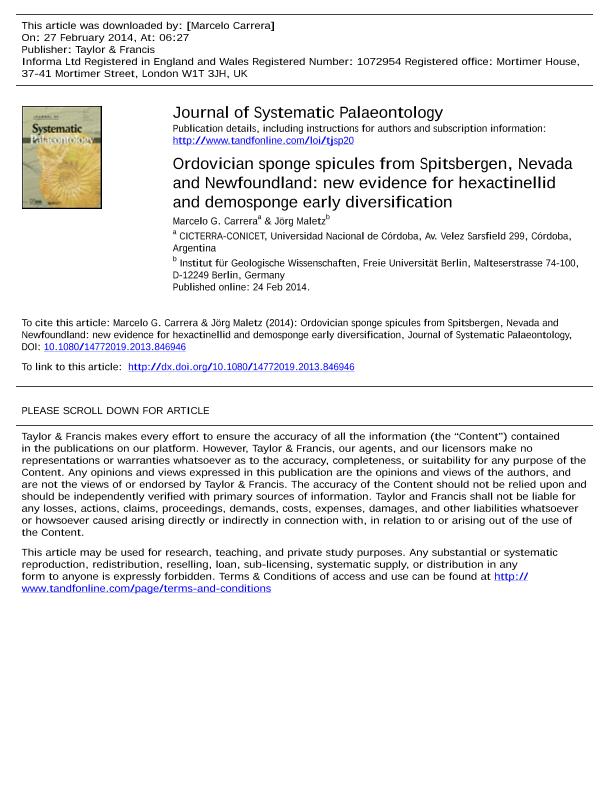Mostrar el registro sencillo del ítem
dc.contributor.author
Carrera, Marcelo Gabriel

dc.contributor.author
Maletz, Jörg
dc.date.available
2017-10-02T21:39:52Z
dc.date.issued
2014-02
dc.identifier.citation
Carrera, Marcelo Gabriel; Maletz, Jörg; Ordovician sponge spicules from Spitsbergen, Nevada and Newfoundland: new evidence for hexactinellid and demosponge early diversification; Taylor & Francis; Journal of Systematic Palaeontology; 12; 8; 2-2014; 961-981
dc.identifier.issn
1477-2019
dc.identifier.uri
http://hdl.handle.net/11336/25690
dc.description.abstract
Unusually well-preserved spicule assemblages from three Lower to Middle Ordovician localities are examined: Spitsbergen (Floian-Dapingian), Nevada (Vinini Formation, Dapingian) and Newfoundland (Cow Head Group, Tremadocian-lower Darriwilian, and Table Head Group, mid-Darriwilian). The recorded diversity increases the knowledge of sponge spicules in the Lower Ordovician and their palaeogeographical distribution. Hexaster type microscleres and scopules, equinate hexactins, pinular hexactins and inflated pentactins and hexactins are the main spicule types amongst the Hexactinellida. Hemidiscs and a possible amphidisc are recorded and can be evidence of the presence of the hexactinellid subclass Amphidiscophora. Oxyasters, C-shaped sigmata and trianes are the main spicule types amongst demosponges. The presence of sigmata and oxyasters can also be evidence of the presence of two main orders of extant demospongids: Sigmatophora (now Spirophorida) and Astrophora. One modified octactinellid spicule type is found from Calcarea. The presence of echinate and pinulate hexactins amongst megascleres suggests a protective functional morphology. These features can be associated with an evolutionary tendency which is seen mainly amongst hexactinellids and demosponges for an efficient occupation of shallower settings and/or a defensive armoury strategy. A newly recorded flat-top pinulate form is also a suitable element for reinforcement or protection of any external surface. Some of the microscleres found can be considered ancient homologues of recent hexasters, sceptrules, hemi/amphidiscs and oxyasters. This work suggests that the microscleres of hexactinellid and demosponge subclasses were already present and significantly diversified in the Early Ordovician. The presence of definite axial canals in scopules provides key evidence for this statement. This finding is significant and confirms the presence of the Sceptrulophora in the early Palaeozoic. The microscleres comes from widely separated Lower Ordovician localities and possess similar forms to those found in Mesozoic microscleres, implying a conservative morphology.
dc.format
application/pdf
dc.language.iso
eng
dc.publisher
Taylor & Francis

dc.rights
info:eu-repo/semantics/openAccess
dc.rights.uri
https://creativecommons.org/licenses/by-nc-sa/2.5/ar/
dc.subject
Ordovician
dc.subject
Sponge
dc.subject
Spicules
dc.subject
Early Diversification
dc.title
Ordovician sponge spicules from Spitsbergen, Nevada and Newfoundland: new evidence for hexactinellid and demosponge early diversification
dc.type
info:eu-repo/semantics/article
dc.type
info:ar-repo/semantics/artículo
dc.type
info:eu-repo/semantics/publishedVersion
dc.date.updated
2017-10-02T19:05:22Z
dc.journal.volume
12
dc.journal.number
8
dc.journal.pagination
961-981
dc.journal.pais
Reino Unido

dc.journal.ciudad
Londres
dc.description.fil
Fil: Carrera, Marcelo Gabriel. Consejo Nacional de Investigaciones Científicas y Técnicas. Centro Científico Tecnológico Conicet - Córdoba. Centro de Investigaciones en Ciencias de la Tierra. Universidad Nacional de Córdoba. Facultad de Ciencias Exactas Físicas y Naturales. Centro de Investigaciones en Ciencias de la Tierra; Argentina
dc.description.fil
Fil: Maletz, Jörg. Freie Universitat Berlin; Alemania
dc.journal.title
Journal of Systematic Palaeontology

dc.relation.alternativeid
info:eu-repo/semantics/altIdentifier/doi/http://dx.doi.org/10.1080/14772019.2013.846946
dc.relation.alternativeid
info:eu-repo/semantics/altIdentifier/url/http://www.tandfonline.com/doi/abs/10.1080/14772019.2013.846946
Archivos asociados
